The ARM vs x86 Wars Have Begun: In-Depth Power Analysis of Atom, Krait & Cortex A15
by Anand Lal Shimpi on January 4, 2013 7:32 AM EST- Posted in
- Tablets
- Intel
- Samsung
- Arm
- Cortex A15
- Smartphones
- Mobile
- SoCs
SunSpider 0.9.1
The results get more interesting when we look at power consumption during active workloads. We'll start off with SunSpider, a mid-length JavaScript benchmark that we frequently use in our reviews:
At the platform level, Qualcomm's APQ8060 powered Dell XPS 10 falls in between Surface RT and Acer's W510. Active power looks very similar to the Intel powered W510, but performance is appreciably slower so total energy consumed is higher.
Looking at the CPU, the situation changes a bit. Intel's peak power consumption is similar to Tegra 3, while Krait manages to come in appreciably lower. I suspect that missing the L2 cache power island here is lowering Qualcomm's power consumption by 100 - 200mW but overall CPU-only power consumption would still be lower. Once again, at idle Krait seems to have a bit of an advantage as well.
The situation changes once we look at GPU power consumption, with Intel/Imagination having the clear advantage here.

Kraken
Mozilla's Kraken benchmark is a new addition to our js performance suite, and it's a beast. The test runs for much longer than SunSpider, but largely tells a similar story:
At the platform level, Acer's W510 has slightly higher peak power consumption compared to the Dell XPS 10 but it also completes the test quicker, giving it a better overall energy usage profile.
Looking at the CPU cores themselves, Qualcomm holds onto its lead here although once again, I suspect the margin of victory is exaggerated by the fact that we're not taking into account L2 power consumption for Qualcomm. Intel does deliver better performance, which allows the CPU to race to sleep quicker than on APQ8060A.
The comparison to Tegra 3 is not surprising, this is exactly what we've seen play out in our battery life tests as well.
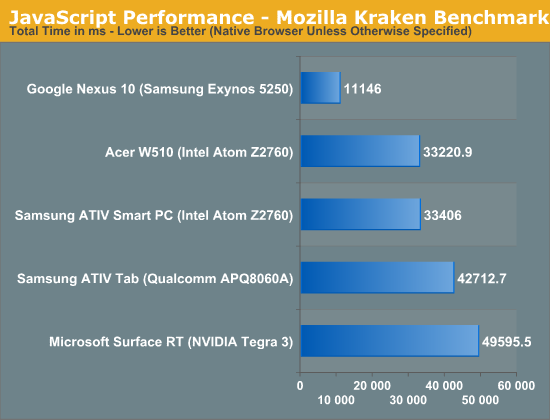
RIABench
RIABench's Focus Tests are on the other end of the spectrum, and take a matter of seconds to complete. What we get in turn is a more granular look at power consumption:
Here the W510 consumes more power at the platform level, but drops to a lower idle state than the XPS 10. Surface RT clearly uses more power than both.
Krait's CPU level (excluding L2 cache) power consumption is once again lower than Atom's, but Atom completes the task quicker. In this case total energy usage is still in Qualcomm's favor. The fact that there's a discrepancy between CPU specific power results and the total platform results are partly due to the missing L2 cache power consumption data from the CPU power chart for Qualcomm, and partly due to differences in the tablets themselves.
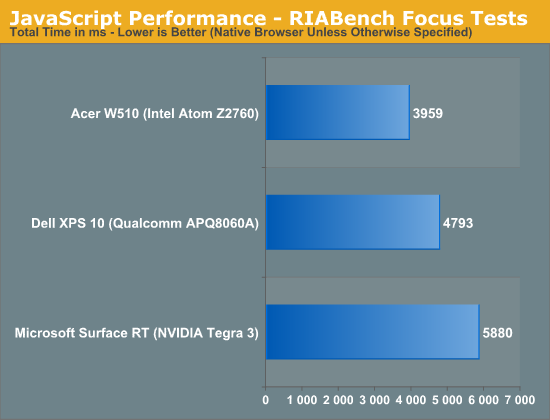


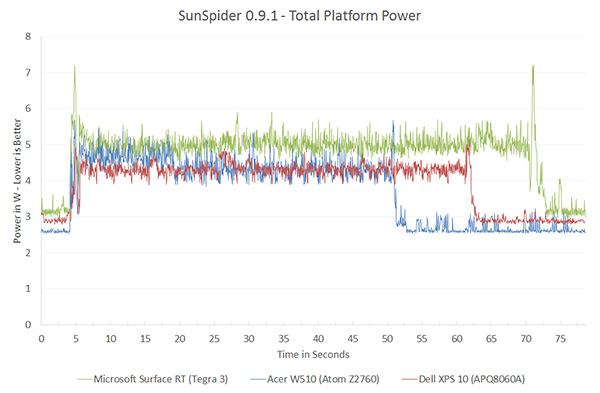


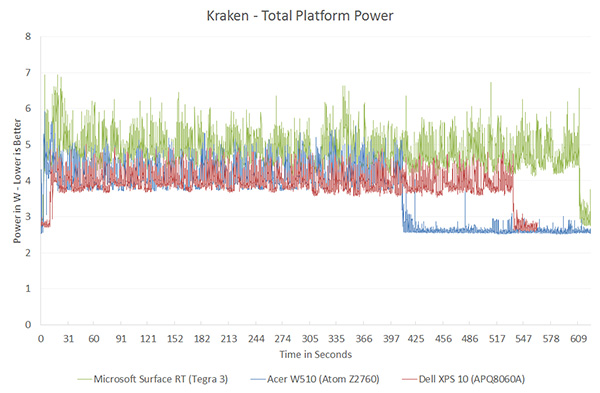
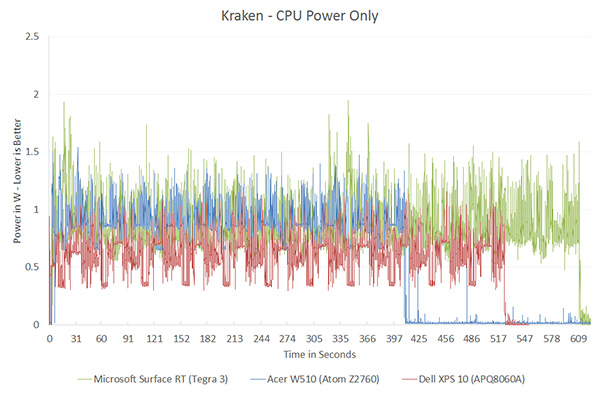
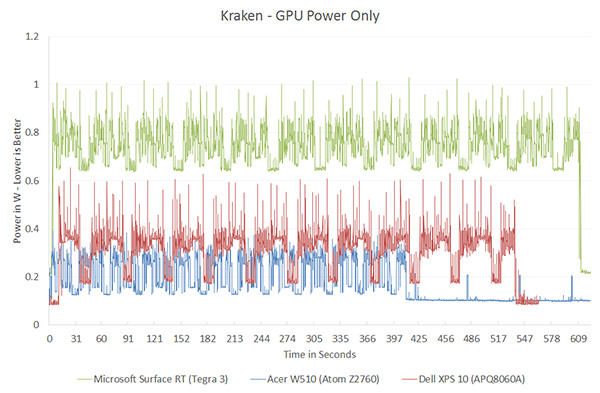
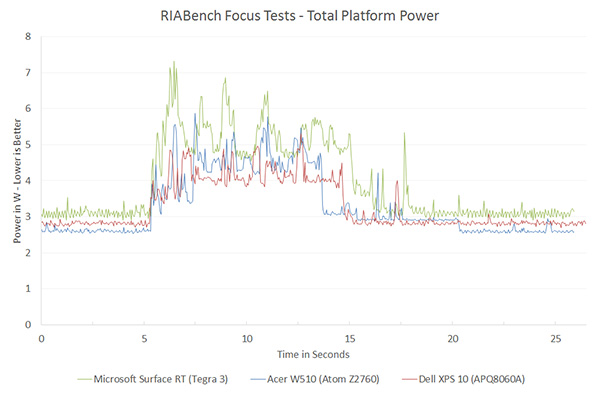
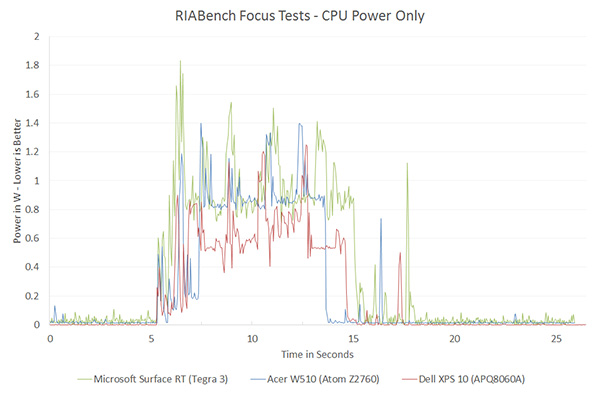
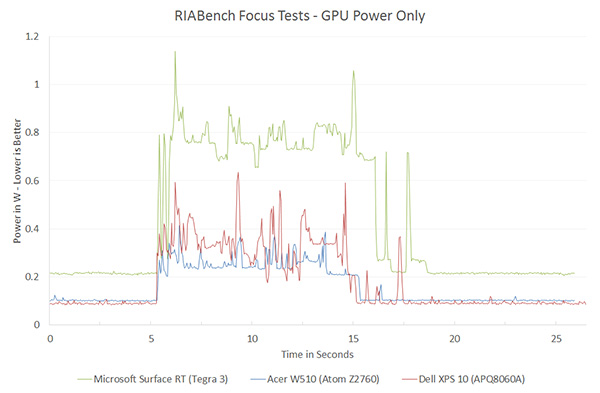








140 Comments
View All Comments
extide - Friday, January 4, 2013 - link
When will you post an article about Bay Trail / Valley View?? Usually you guys are pretty fast to post stuff about topics like this yet I have seen some info on other sites already...jpcy - Friday, January 4, 2013 - link
...which I bet CISC users thought had ended about 18 years ago...It's good to see a resurgence of this highly useful, extremely low-power and very hardy British CPU platform.
I remember back in the day when ARMs were used in the Acorn computers (possibly too long ago for most to remember, now - I still have an A7000 and a RISC PC with both a StrongARM and a DX2-66 lol) was at war with Intel's Pentium CPU range and AMD's K6's, boasting an almost 1:1 ration of MIPS:MHz - Horsepower for your money (something Intel and AMD were severely lacking in, if I remember correctly.)
And now, well, who'dve thought it... These ARM CPUs are now in nearly everything we use... Phones, smartphones, tablets, notebooks...
Suppose I was right in the argument with my mate in school afterall... RISC, superior technology (IMHO) may well take over, yet!
nofumble62 - Friday, January 4, 2013 - link
No performance advantage, no battery life advantage. Why anyone would bother with incompatible software?sseemaku - Friday, January 4, 2013 - link
Looks like people have changed religion from AMD to ARM. Thats what I see from some comments.mugiebahar - Saturday, January 5, 2013 - link
Yeah n no. They wanted a no paid opinions to screw with the outcome. But Intel hype won over real life .Intel better and will get better - yes
Any chance they will compete (performance and PRICE) and legacy. Support to phone apps - Never in the near future which is the only time for them.
tuxRoller - Saturday, January 5, 2013 - link
Also, any chance for an actual performance comparison between the platforms?Apple's performance and power use look awesome. Better than I had imagined.
I'd love to see how they compare on the same tests, however.
Kogies - Saturday, January 5, 2013 - link
It appears the war has begun, well two wars in fact. The one you have articulately described, and the oft ensuing war-of-words...Thanks Anand, I appreciate the analysis you have given. It is excellent to get to see the level of granularity you have been able to achieve with your balance of art and science, and knowing where to hook into! I am very interested to see how the L2 cache power draw effects the comparison, just a little jitter in my mind. If nothing else, it looks as if the delicate balance of process tech., and desired performance/power may have a greater bearing on this "war" than mere ISA.
With Krait 300, Haswell, and more A15's this is going to be a tremendous year. Keep up the good work.
Torrijos - Saturday, January 5, 2013 - link
Any chance we could see the same tests run on the latest Apple iPad?That way we could have a chance to see what Apple tried to improve compared to the A15 generation.
urielshun - Saturday, January 5, 2013 - link
The whole discussion about ARM and x86 is not important when you go for the ecomonics of each platform. ARM is dirty cheap and works well. It's 1/10th of the price of any current Atom with decent perfomace (talking about RK3066).Don't underestimate the Chinese they are having a field day with ARM's pricing model and and have shown amazing chips.
In 8 years from now all SoC's would have reached the usuable performace and the only thing that will matter will be power and cost of integration.
iwod - Saturday, January 5, 2013 - link
Where are you getting 1/10 of a price from? Unless they are produced on good old 40nm LP Node with Nothing else, or crap included, otherwise there just aren't any Chinese SoC selling for $4